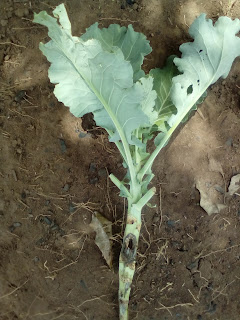How to Identify Black Rot Disease on Cruciferous Vegetables
Most
farmers incur losses in vegetable farming as a result of black rot disease. In
most circumstances, they use wrong controlling measures because of the paucity
of information on black rot disease. For these reasons, farmers need to know
how to identify and control black rot on their cruciferous vegetables.
What
is black rot?
Black
rot is known by different names such as stump rot, blight, stem rot, black
vein, and black stem. It is a bacterial disease, which is caused by Xanthomonas
campestris pv. campestris. The bacterium affects cruciferous crops. Cruciferous
crops belong to Brassicaceae or Cruciferae family. This family contains
vegetables such as kales, cabbages, spinach, Brussel sprouts, garden cress, cauliflower,
broccoli, bok choy, and other leafy vegetables. Even though black rot attacks
all cruciferous vegetables, it rarely affects kales and radish.
 |
| Affected leaf |
The
life cycle of campestris
The
bacterium occurs in the materials of affected vegetables until they fully
decomposed. After decomposition, the bacterium remains in the soil between 40
and 60 days. It is transferred from one crop to another by insects, wind, animals,
farm equipment and splashing water. Campestris enters vegetable leaves via
stomata, hydathodes, and any injury. Subsequently, it attacks the vascular
system. Moreover, its effects can be recognized between 5 and 15 hours after
the attack.
 |
| Effect of black rot |
How
to identify black rot in cruciferous vegetables
The
campestris infection results in two types of symptoms, which depend on
the type of infection (local or systematic infection). Vegetable seedlings that
the bacterium infects systematically become yellow, and then shade lower leaves,
and finally die. On the other, cruciferous vegetables that are infected
systematically take time before developing any symptom.
Identify
the black rot disease in cruciferous vegetables by observing the existence of chlorotic-narcotic
V-shaped spots originating from the margin of the leaf. The affected vegetable
tissues become pale yellow, yellow, and then brown, and eventually wilt and
die. In serious cases, vegetable heads remain small, their quality reduced, and
prematurely die. The veins of infected roots stem and leaves sometimes turn
black due to loss of water. The bacterium releases polysaccharide, an extracellular
substance that interferes with the normal flow of water in the leaves, stems
and roots of the crops. The blackened veins are recognized by cutting across
the petioles of leaves and stems. Blackened veins and dark spots can also occur
on the cotyledons. In some cases, the development of black rot may lead to soft
rot, causing serious destruction to the crops.
Management
and control measures
The
chemical method is an effective technique for controlling black rot disease. Copper-based
fungicides are used to control campestris. Other methods such as planting
resistant varieties, crop rotation, planting certified seedlings, controlling cruciferous
weeds, regular inspection of seedlings and destroying the affected seedlings,
proper drainage, and avoiding overhead irrigation are also used in managing and
controlling black rot disease.
Conclusion
Identify
black rot disease by observing the occurrence of chlorotic-narcotic V-shaped
spots on the leaves, and pale yellow, yellow and brown tissues. Furthermore,
cut across the petioles of the leaves and stems and check the presence of
blackened veins. Assessing the development of soft rot is also necessary to
ascertain that the cruciferous vegetables are affected by Xanthomonas
campestris pv. campestris. After the identification of the black rot
disease, use any of the control and management measures that may solve the
condition of your cruciferous vegetables.




Comments
Post a Comment